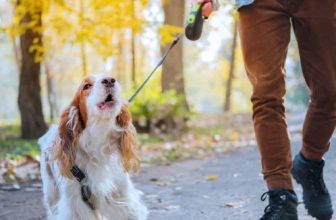How Do You Train Your Dog to Stay: Expert Tips and Tricks

How Do You Train Your Dog to Stay? Training your dog to stay is essential for good behaviour. It helps keep your pet safe and makes your life easier.
Every dog owner wants a well-behaved pet. Teaching your dog to stay can be one of the most important commands. It keeps your dog in one place, whether you are at home or out in public. This skill is not just about control; it also ensures your dog’s safety in busy environments.
With patience and practice, you can train your dog to stay in a specific spot. Understanding the right techniques can make this process enjoyable for both you and your furry friend. Let’s explore effective methods to help your dog learn this valuable command.
Introduction To Dog Training
Teaching your dog to stay is very important. It helps keep your dog safe. A dog that stays put won’t run into danger. This skill is also good for obedience.
Train your dog to stay can be simple. Use clear commands. Always reward your dog for good behaviour. Treats or praise work well. Be patient and consistent. Dogs learn best with practice.
Start in a quiet place. Fewer distractions help your dog focus. Gradually increase the difficulty. Try different locations and situations.
Preparing For Training Sessions
Choosing the right environment is very important for training. A quiet place helps your dog focus. Avoid busy areas with many people or loud noises.
Use a fenced yard or a calm room inside. Make sure there are no distractions. This helps your dog learn better.
Gathering necessary supplies is also key. Use treats to reward good behaviour. A leash is helpful for control. Have some toys ready to keep your dog engaged.
Make sure to have a clicker if you use clicker training. A comfortable mat can help your dog relax. All of these items will make training easier.
Understanding Your Dog’s Learning Process
Dogs learn in many ways. They respond to rewards and punishments. A reward can be a treat or praise. Punishment can be a firm “no.” Understanding what your dog likes helps. This improves learning.
Watch your dog’s body language. Signs of readiness include wagging tails and relaxed ears. Signs of stress include tucked tails and whining. Recognising these signs is important. It helps you adjust your training.
| Behavior | Sign |
|---|---|
| Ready to Learn | Wagging Tail |
| Stressed | Tucked Tail |
| Excited | Bright Eyes |
| Frustrated | Whining |

How Do You Train Your Dog to Stay
Credit: m.youtube.com
The ‘stay’ Command: Step-by-step Guide
Start by getting your dog into the right position. Have your dog sit in front of you. Make sure they are focused on you.
Now, say the word “stay” clearly. Use a calm and firm voice. Hold your hand up like a stop sign. This helps your dog understand the command.
If your dog moves, gently bring them back. Repeat the command and try again. Always reward them with praise or a treat when they stay.
Practice this step often. Dogs learn best with repetition. Keep training sessions short and fun. This helps your dog stay engaged and happy.
Gradually Increasing Difficulty
Start with a short time for the’stay’ command. Begin with just a few seconds. Gradually increase this time. Reward your dog for staying longer. This helps them learn.
Next, add some distance. Take a few steps back while your dog stays. Slowly increase the distance over time. Always reward good behaviour. This makes your dog feel happy.
Distractions can be tricky. Begin in a quiet place. Once your dog stays well, try a busier area. Use treats to keep their focus. This helps them learn to stay no matter what.
Positive Reinforcement Techniques
Using positive reinforcement helps train your dog. Give your dog effective rewards for good behaviour. These rewards can be treats, toys, or praise. Timing is very important. Give the reward right after the good behaviour.
As your dog learns, start phasing out treats. Use treats less often. Replace treats with praise or playtime. This helps your dog stay motivated. It also makes training fun. Always celebrate small successes.
Consistency is key. Train in short sessions. Keep it simple. Your dog will learn better this way. Remember, patience is important. Each dog learns at their own pace.
Troubleshooting Common Issues
Breaks in the’stay‘ command can be frustrating. Dogs might break the stay because of distractions. Use a quiet space for training. Start with short durations. Gradually increase the time as your dog improves.
Adjust your training approach if needed. Try using treats as rewards. Praise your dog when they stay. Keep training sessions short and fun. If your dog breaks the command, gently guide them back. Repeat the command calmly.
Consistency is key. Always use the same command. Make sure everyone in the household uses the same words. This helps your dog learn faster. Patience is important. Every dog learns at their own pace.
Advanced Training And Beyond
Teaching your dog to stay can be fun. Use daily moments for practice. For example, ask your dog to stay while you eat. This builds good habits.
Start with short times. Gradually increase the duration. Reward your dog with treats or praise when they stay. Consistency is key.
Incorporate the stay command in walks. Ask your dog to stay at crosswalks. This keeps them safe and reinforces training.
Next, explore new commands. Focus on come and leave it. These commands help in different situations.
Train in various locations. Dogs learn better with new sights and sounds. Keep sessions short and fun.
Maintaining Consistency And Patience
Training your dog needs consistency and patience. Set a regular training schedule. This helps your dog learn better. Try to train at the same time each day. Short sessions work best. Keep them fun and positive.
Using the same commands is very important. Dogs need to hear the same words each time. This helps them understand what you want. Always use a calm voice. Praise your dog when they follow commands. This will motivate them to do better.
Stay patient during training. Some dogs learn faster than others. If your dog does not understand, try again later. Celebrate small successes. This builds your dog’s confidence and trust in you.

How Do You Train Your Dog to Stay
Credit: www.dog-training-excellence.com
The Role Of Exercise And Mental Stimulation
Dogs need regular exercise. This helps them focus better. A tired dog is a happy dog. Walks, runs, and fetch can improve their mood.
Try different activities. Play with a ball or frisbee. Go for hikes. This keeps your dog active and engaged. A well-exercised dog listens better.
Mental games are also important. Use toys that challenge their mind. Hide treats around the house. Let them find the treats. Puzzle toys can keep them busy.
Training sessions can be fun. Mix commands with games. This makes learning enjoyable. A dog that has fun will want to learn more.
Expert Tips For Success
Every dog is unique. Their personality affects how they learn. Understanding your dog’s traits helps customise training.
Some dogs are very energetic. They may need more breaks. Others may be calm and focused. They can learn quickly.
Use positive reinforcement. Reward good behaviour with treats or praise. This method works well for all types of dogs.
Be patient and consistent. Training takes time. Short sessions are better than long ones.
Always keep training fun. Games and play help keep your dog interested. A happy dog learns faster.
Conclusion: The Lifelong Journey Of Training
Training a dog is a long journey. Celebrate every milestone along the way. Each success, big or small, matters. It shows your dog is learning.
Keep learning together. Attend training classes for new skills. Read books about dog behaviour. Join groups where you can share ideas. Stay engaged with your dog.
Remember, training is a team effort. You and your dog grow together. Enjoy every moment of this special bond.

How Do You Train Your Dog to Stay
Credit: petstek.com
Frequently Asked Questions
How Can I Teach My Dog To Stay?
To teach your dog to stay, start in a quiet space. Use a leash for control and give the command “stay. ” Reward them with treats when they remain in place. Gradually increase the distance and duration before offering a reward.
Consistency is key for effective training.
What Is The Best Age To Train A Dog To Stay?
You can start training your dog to stay as early as 8 weeks old. Puppies can learn basic commands quickly. However, older dogs are also capable of learning new behaviours. Patience and positive reinforcement will help regardless of their age.
Make training a fun experience for your dog.
How Long Should I Train My Dog To Stay?
Training sessions should be short and engaging, lasting about 5 to 10 minutes. Frequent, brief sessions are more effective than long ones. Aim for multiple training sessions throughout the day. This keeps your dog focused and eager to learn. Consistency helps reinforce the “stay” command.
What Should I Do If My Dog Breaks The Stay Command?
If your dog breaks the stay command, calmly redirect them back to the original position. Avoid scolding, as this can create anxiety. Instead, reinforce the command with a treat when they comply. Practice frequently in different environments to improve their focus.
Patience is essential in this process.
Conclusion
Training your dog to stay takes patience and practice. Break the process into small steps. Use rewards to encourage good behaviour. Stay consistent with your commands. Keep training sessions short and fun. Celebrate each success, no matter how small. A well-trained dog brings joy and safety.
Enjoy the bond you create through training. With time, your dog will learn to stay with ease. Trust in the process and stay committed. Your efforts will lead to lasting results.







[…] by teaching your dog to stay for short times. Use a treat to grab their attention. Say “stay” and then step back.If […]